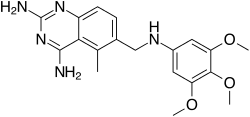Trimetrexate
Trimetrexate is a quinazoline derivative. It is a dihydrofolate reductase inhibitor.[1]
 | |
| Clinical data | |
|---|---|
| AHFS/Drugs.com | Consumer Drug Information |
| MedlinePlus | a694019 |
| ATC code | |
| Pharmacokinetic data | |
| Bioavailability | VD: 20-30 Liters |
| Metabolism | Oxidative O-demethylation, followed by conjugation with glucuronide or sulfate |
| Elimination half-life | 11 to 12 hours |
| Identifiers | |
IUPAC name
| |
| CAS Number | |
| PubChem CID | |
| IUPHAR/BPS | |
| DrugBank | |
| ChemSpider | |
| UNII | |
| KEGG | |
| ChEMBL | |
| CompTox Dashboard (EPA) | |
| Chemical and physical data | |
| Formula | C19H23N5O3 |
| Molar mass | 369.418 g/mol g·mol−1 |
| 3D model (JSmol) | |
SMILES
| |
InChI
| |
| (verify) | |
Uses
It has been used with leucovorin in treating pneumocystis pneumonia.[2]
It has been investigated for use in treating leiomyosarcoma.[3] It is a methotrexate (MTX) analog that is active against transport-deficient MTX-resistant tumor cells that overcome the acquired and natural resistance to methotrexate. Other uses include skin lymphoma. [4]
References
- Wong BK, Woolf TF, Chang T, Whitfield LR (1990). "Metabolic disposition of trimetrexate, a nonclassical dihydrofolate reductase inhibitor, in rat and dog". Drug Metab. Dispos. 18 (6): 980–6. PMID 1981548.
- Sattler FR, Allegra CJ, Verdegem TD, et al. (January 1990). "Trimetrexate-leucovorin dosage evaluation study for treatment of Pneumocystis carinii pneumonia". J. Infect. Dis. 161 (1): 91–6. doi:10.1093/infdis/161.1.91. PMID 2136905.
- Smith HO, Blessing JA, Vaccarello L (January 2002). "Trimetrexate in the treatment of recurrent or advanced leiomyosarcoma of the uterus: a phase II study of the Gynecologic Oncology Group". Gynecol. Oncol. 84 (1): 140–4. doi:10.1006/gyno.2001.6482. PMID 11748990.
- Trimetrexate in relapsed T-cell lymphoma with skin involvement. J Clin Oncol. 2002 Jun 15;20(12):2876-80.
This article is issued from
Wikipedia.
The text is licensed under Creative
Commons - Attribution - Sharealike.
Additional terms may apply for the media files.